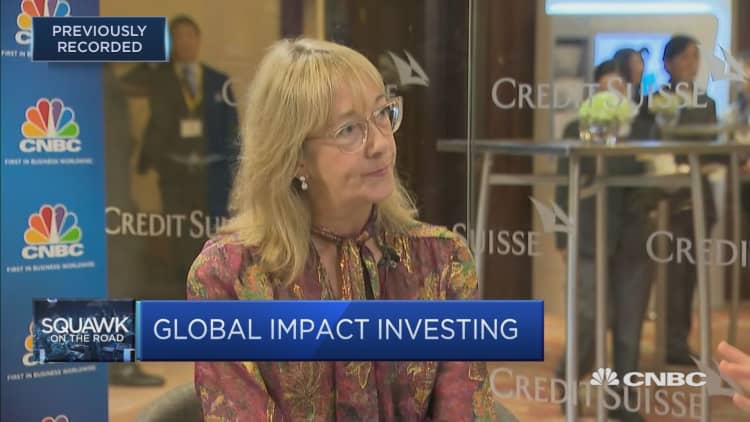A team of five graduate business students from the University of Vermont traveled to Philadelphia this week to put an impact investing project they have been working on to the test.
The trip, which coincided with finals, was a success.
The students — Maura Kalil, Emily Klein, Andrew Mallory, Peter Seltzer and Alyssa Stankiewicz — took the top prize in the Total Impact Portfolio Challenge. The competition was put together by Bank of America, the University of Pennsylvania's Wharton Social Impact Initiative, and the Good Capital Project.
The competition pitted 26 teams of graduate student teams from 19 schools against each other with one purpose: to come up with a unique investment take on impact investing.
The inaugural competition issued a challenge to students: to come up with an impact investing strategy for either a single family office with $100 million or a family foundation with $25 million.
The competitors — including finalist teams from Boston University, Columbia University, Fordham University, University of Vermont and Yale University — came up with ideas that upended traditional notions about impact investing, according to the organizers.
All of the teams worked with about 50 mentors from Bank of America, including wealth advisors, portfolio managers and sustainability experts.
"The key takeaway is that there are many ways in which you can integrate ESG [environmental, social and governance] and impact," said Sharadiya Dasgupta, managing director at Good Capital Project. "That is one thing practitioners should learn from this exercise."

The winning team came up with a portfolio for a family office with $100 million through a mix of investments including community development loan funds and private debt impact funds. It also included direct investments in farmland, timber and a holding company.
The team also came up with its own screen for ESG funds, called SI-MBA after their own MBA program, that evaluated how well their investments aligned with the issues most material to the companies they invest in.
At the competition event on Wednesday, the University of Vermont team presented their concept at the end of the day. That gave them the opportunity to listen to other teams' projects, they said, and feel validated that they were on the right track, they said.
"I could feel the excitement and the interest in the ideas that we're bringing as students and as millennials and people who are going to be working in this space soon," Klein said.
The competition is evidence that impact investing is being embraced in schools, professionals involved in the project said.
"Students these days are embracing responsible capitalism," said Jackie VanderBrug, head of sustainable and impact investment strategy in the chief investment office for Merrill and Bank of America Private Bank. "They are looking for how does information like environmental, social and governance data support them in making better investment decisions."
Changing opportunities
When the Wharton Social Impact Initiative was started in 2010, its focus was more on private equity and venture capital. Today, that has expanded more broadly to include impact investments.
That matches the growth that has happened in ESG funds and thematic exchange traded funds.
"The costs have come down," VanderBrug said. "The product breadth has grown, and the track records have grown."
That means that what was once an investment area reserved for just accredited investors — those with at least $200,000 in income or a net worth of $1 million or more — is now accessible to individuals of most levels of wealth.
The number of sustainable funds has grown, according to Morningstar's latest annual report on the topic. In 2018, the number of sustainable equity and bond funds reached 351, up from 235 the previous year. Collectively, the funds managed $161 billion.
For Bank of America, that means clients can now access these investments from its Merrill Edge business targeting mass affluent individuals, up through the private bank that caters to the wealthiest individuals.
"Our commitment at Bank of America is that all of our clients should have the power to have impact through their portfolios," VanderBrug said.
Those industry changes are also evident at Wharton, where every fall about 250 MBA students out of approximately 850 express interest in social impact, according to Nick Ashburn, senior director at the Wharton Social Impact Initiative.
The department typically sees six applicants for every one spot in impact investing related projects.
"We definitely see demand outstripping our current supply at the Wharton Social Impact Initiative, and we look to grow that," Ashburn said.
After graduation, there are more students who are pursuing careers in impact investing, Ashburn said. And even if they do not go that route, the chances are greater that their jobs will eventually touch on the topic in some way, he said.
More from Impact Investing:
Not just millennials have impact investing in their game plan: Study
Homeowner ditches 'energy guzzlers' for more efficient options
Trump order brings scrutiny to eco-conscious 401(k) investments
For the winning team from the University of Vermont, careers in impact investing are the ultimate goal.
The students are part of the school's one-year Sustainable Innovation MBA program. While all five students had prior careers in business, they plan to pursue jobs in impact investing after they graduate in August.
The experience of the contest, they said, should help those efforts.
"The challenge has allowed us to dig deep to learn more about the industry and the power of what capital can do for the world to make it a better place," Kalil said.


